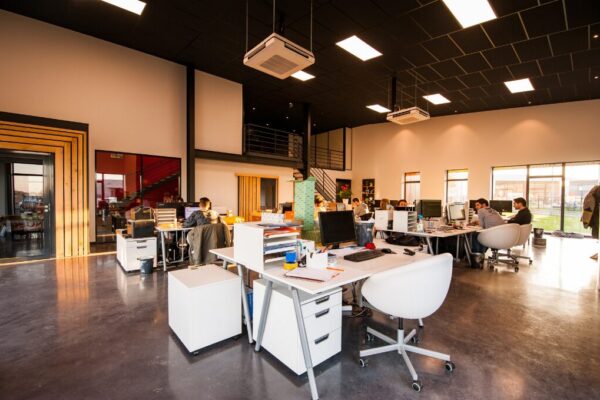According to Eamonn Ryan, Minister, the Irish government is poised for a return to the office in September, after over 18 months of forced working from home, as the health and safety needs of staff were prioritized following the onset of the COVID-19 pandemic. Employers and business now face the challenge of navigating this return to offices, in an environment where the impact of COVID-19 is still a daily reality for the populace.
How do employers and businesses keep operations in the office environment going, while minimizing the risk to employees?
For the past 15 months, most companies have adapted new ways of working that have left their offices, factories, shops and other facilities relatively empty. These adaptations were often a knee jerk reaction to the restrictions imposed as a response to the pandemic, and as we face the re-opening of society, many staff are preparing to return to their office environment.
Facility Management teams bore the primary responsibility for steering their companies through this disruption. Now it will be up to these teams to determine how and when to start the complex task of returning employees to the workplace once government restrictions are lifted.

It is important that as staff return, that management recognise the problems a returning workforce may face. Effective management of resources, coupled with availing of new technologies developed to support flexible working, can assure a seamless return of staff in a safe and effective manner.
If these challenges are effectively acknowledged, understood and appropriately mitigated, then there is an opportunity for companies to chart a realistic course from crisis to recovery to optimum performance.
Staff safety must come first. How do management ensure this occurs?
Any operation is only as good as the staff that deliver the product or service. Workforce health and safety must be managements’ top priority as operations return to ‘normal’. Given that the government advice currently is that all offices may reopen in September, companies must ensure that offices are safe for their workers. Corporate vision or mission statements must recognise that there is a moral, ethical and legal duty of care for all companies in how they support staff in this challenging environment. From a business perspective, effectively safeguarding all employees’ well-being must be uppermost since ‘normal’ operations can not successfully resume without staff ‘buy in’. Staff have an expectation and need for facility management leaders to exhaust every possibility to maximise well being and health and safety responses, prior to their return to an office setting. Given that there may be future unknown COVID-19 variants, managers need to plan for a range of scenarios, depending on future potential government restrictions.
The challenge of re-opening
The challenge of re-opening and keeping offices safe is a difficult one. However, maximising the use of available technologies and adapting new protocols for deep cleaning and sanitisation may be needed. Examination of the layout of offices may also be considered and changed as appropriate. It may be timely to establish new protocols on the use of personal protective equipment and implement same. Consider establishing rules governing when employees can return to work after recovering from infection, in line with health advice. Up to date technology may be harnessed to facilitate contact tracing and communicate with other employees who’ve been exposed to the virus and need to self-quarantine. However, in the event that steps like these are being considered, it is a priority to make sure robust protocols are in place to safeguard workers’ personal data/privacy.
Analyzing the situation
As management teams work to get their businesses back on track, most will probably focus on getting employees who really need to be in the office or on the factory floor back into the building as soon as it is safe and practicable to do. An analysis of which roles transitioned smoothly to remote working and which didn’t, should help inform decisions about when prioritising employees return to the workplace. It may make sense to allow people in jobs with little drop-off in productivity to continue to work remotely for a period of time to reduce onsite headcount. However it is important that all staff are valued, and given the opportunity to return to the office in a fair, equitable and flexible arrangement, as per company need. In order to maximise employee ‘buy in’ Managers must be seen to have implemented changes in order to mitigate any potential health and safety concerns that returning employees may experience.
Points, in the management of these changes, to consider:
- An understanding and acknowledgement by management that although all employees have experienced this crisis, they may not all have experienced it the same way, depending on their or their families health situation. Managers and employers need to show empathy and sensitivity with returning staff.
- Transparent communication of changes in the workplace to staff, with an appropriate lead in time given to digest any new processes or procedures which have been implemented.
- It is essential to recognize that workforces will need time to adapt to new ways of working post-pandemic. Employees coming back after a period of remote work may find the physical layout of their workplace changed and their schedules altered. A mindset shift for those who’ve adjusted to working remotely may be required. In order to make these changes as seamless as possible, management should ensure employees understand what’s being asked of them and detail the steps the company is taking to protect their health.
- Given that flexible options for returning to work may be appropriate, employers should have an effective communication strategy which will help employees who are returning to the workplace, as well as those who continue to work remotely, embrace a shared vision of what comes next.
- New protocols and procedures for effective regular deep cleaning of the office, and the implementation of personal sanitisation procedures.
- Increased distance between work stations and the use of new technologies to allow scheduled desking booking e.g. Ronspot to facilitate a managed and fair approach to office return, are also imperative.
- Defined processes for all staff to enable them to know clearly what they need to do in the event that they show symptoms of the virus or have been in close contact with someone who has been diagnosed as COVID-19 positive should be communicated to employees prior to their return to the office.
Providing employees with the chance to make their challenges and concerns known may help management teams identify potential problems with their return-to-the-workplace plans. Once real, two-way communication is available for all staff and employers, management may turn the COVID-19 crisis into an opportunity to strengthen culture, increase employee engagement and loyalty, maximise corporate resources and realise an increased productivity in the future.



